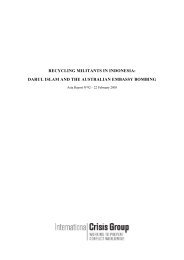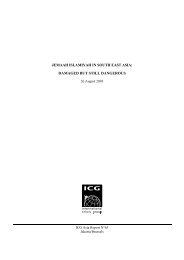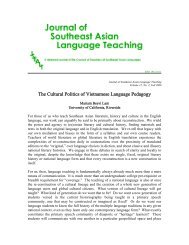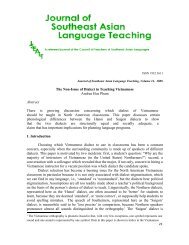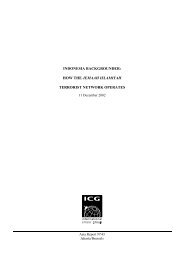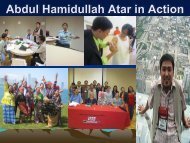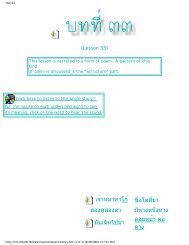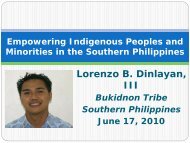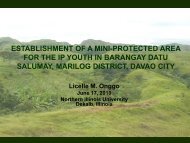Introduction - SEAsite - Northern Illinois University
Introduction - SEAsite - Northern Illinois University
Introduction - SEAsite - Northern Illinois University
Create successful ePaper yourself
Turn your PDF publications into a flip-book with our unique Google optimized e-Paper software.
Prentation Abstracts<br />
Anna Karlström<br />
Lao History Stories—Towards Multivocality in History Writing<br />
Department of Archaeology and Ancient History, Uppsala <strong>University</strong>, Sweden<br />
The history of a country sometimes has a tendency to start with the establishment<br />
of a state or states in that particular area. The idea of a unified nation, where<br />
nation borders were much the same as those today, and the idea of a people, unified<br />
by and homogenous within that nation are essential in the conceptualization of a<br />
country’s history. The formation of Lane Xang kingdom in the mid 14th century is<br />
often set as the starting point for the history of Laos.<br />
In this paper I will use the results from last years’ archaeological fieldwork in<br />
Vientiane Province to discuss what happens when myths and legends concerning<br />
origin and history of Laos, and archaeological research including survey and excavation<br />
meet. In this case they meet in Viengkham, a site which to some extent were<br />
significant in the formation of Lane Xang kingdom, but also indicates a continuity<br />
of human activity and early state formation from the 7th to 8th century.<br />
Laty Keodouangsy** and Kalyani Rai*<br />
Project Voices, Individuals, and Pictures: Engaging Hmong<br />
Parents, Schools, and CBOs to Support Student Learning<br />
and Academic Achievement<br />
*Assistant Professor, UW—Milwaukee School of Continuing Education<br />
**Advisor, Dept. of Curriculum & Instruction, UW—Milwaukee, Wisconsin<br />
Prevailing attempts to address the lack of parental involvement in children’s<br />
schools are based on “middle class Anglo-American value systems” on traditional<br />
parental roles in the schools. This approach to address the lack of parental involvement<br />
in children’s schools is essential but not adequate for many Southeast Asian<br />
parents who are considered limited English proficient and particularly, Hmong<br />
refugee parents. It fails to recognize culturally specific parental involvement strategies<br />
in the SEA community and therefore presents a challenge for educators and<br />
schools alike to understand and communicate meaningfully with these parents<br />
concerning their children’s education.<br />
This paper documents Participatory Action Research with a group of Hmong<br />
refugee parents, community-based organizations, teachers, and School administrators<br />
who share concerns about their children’s education with a focus on the<br />
strategies these parents use to guide and help their children despite linguistic and<br />
cultural barriers.<br />
The presentation is divided into five sections: <strong>Introduction</strong>, PAR methodology,<br />
Findings, Implications, and Conclusions. The introduction section gives<br />
an outline of the most prevailing approaches to address parental involvement in<br />
schools. The second section provides an overview of a participatory action research<br />
strategy. The findings section explains the major themes that have emerged<br />
from the discussion and concludes with a set of implications for educators concerned<br />
about involving SEA parents in their children’s education.<br />
The conclusion examines how the recent No Child Left Behind act and the<br />
issues concerning student academic achievement and increased parental involvement<br />
in schools are critical issues that are being addressed in mainstream and<br />
culturally-appropriate ways. Through dialogue, action, and reflection employed<br />
through the duration of the project, we gather information about how Hmong parents<br />
and students navigate the American school system and practice naturally occurring<br />
strategies to help students learn in schools.<br />
Vanpheng Keophannha<br />
From Dusty Cobwebbed Piles to Golden Jewel: 8 Years of Transformation<br />
of the Luang Prabang Palace Museum<br />
Deputy Director Royal Palace National Museum, Luang Prabang, Lao PDR<br />
This is a first person story. I was hired by the Luang Prabang Department<br />
of Information and Culture in 1997 as an assistant collections manager of the<br />
Luang Prabang National Museum. In the late 1980s the Lao government decided<br />
to develop its tourism sector, but when I walked into the Museum for the first time<br />
in 1997, little had been done to develop the building as a Museum since 1976.<br />
The total professional staff at that time was 3, a Director, a Deputy Director, and<br />
me. As the first person with a background in museology to work in the Museum,<br />
I experienced a range of initial overwhelming impressions-- from the complexity<br />
of the job from registration to preservation; to the dust that needed to be cleaned<br />
off every surface from glassware to thrones; to the exhibitry the needed to be<br />
developed to explain the time and meaning of this building and its contents to the<br />
modern world. Over the past 8 years I have encountered problems ranging from<br />
how to develop a modern registration system without computers; to preservation<br />
of delicate materials such as royal silk clothing or old photographs and negatives<br />
without a conservation department. Fortunately, I have had several opportunities<br />
for additional training in collections management and textile conservation. My<br />
paper will detail the steps and challenges I have encountered in bringing the Palace<br />
from abandoned residence to a National Museum in a World Heritage Town.<br />
Channapha Khamvongsa*, Sary Tatpaporn**, Bounthanh<br />
Phommasathit***, Lee Thorn****<br />
Legacies of War: A Project on the Secret U.S.<br />
Bombings in Laos<br />
*New York, NY, Presentation Chair<br />
**Richmond, CA<br />
***Cleveland, OH<br />
****San Francisco, CA<br />
The secret U.S. bombings of Laos during the Vietnam War era branded it the<br />
most bombed country in all of warfare history. Yet, the bombings and the legacy<br />
of Laos, being heavily littered by deadly unexploded ordnances, remain unknown<br />
to most of the world today. Unauthorized by Congress, the U.S. bombings killed<br />
and injured tens of thousands, and displaced countless Lao from their homes. The<br />
illegality of the bombings has led to suggestions that the U.S. military aggression<br />
is a crime of war and a violation of human rights.<br />
Thirty-years after the last bombs were dropped, a group of Lao-Americans<br />
and supporters are organizing to unearth this obscure chapter in U.S. history. Legacies<br />
of War is an education and advocacy project which seeks to raise awareness<br />
about the fatal American bombings and to develop strategies for increasing the<br />
role of the U.S. in the removal of unexploded ordnances and in the assistance to<br />
survivors. Legacies of War will also draw attention to the victims and survivors<br />
of the bombings, whose faces, voices and humanity are often forgotten in the discourse<br />
of warfare.<br />
The panel will include presentations from the above authors, along with<br />
display of historic illustrations drawn 30-years ago in Laos by survivors of the<br />
secret American bombings. The panelist will include Lee Thorn, formerly with<br />
the U.S. Navy, who loaded cluster bombs on U.S. planes destined for Laos. Mr.<br />
Thorn is featured in the film “Bombies,” which is scheduled to be screened at the<br />
conference. Ms. Bounthanh Phommasathit is a survivor of the bombings in Xieng<br />
Khoang.<br />
Hyakumura Kimihiko<br />
The “Slippage” Implementation of the Forest Policy by Local<br />
Officials: A Case Study of the Protected Areas of Savannakhet<br />
Province, Laos<br />
Forest Management, Research Associate, Forest Conservation Project, Institute<br />
for Global Environmental Strategies, Japan<br />
Recently, the concept of decentralization has been introduced lots of Southeast<br />
Asian Countries. In the forestry section of Laos, it has been also shown not<br />
only the re-organization of the administration system such as power transfer of<br />
lower authority, but also policy re-forming such as land and forest allocation program.<br />
An important and progressive part of the forest policy regime in Laos is its<br />
land and forest allocation program started in 1996, which contains critical elements<br />
that delegate the rights of land and forest use to local people. This study<br />
aims to analyze the gap between the initial concept of the program and its actual<br />
implementation by local forestry officials and discuss several issues with the program<br />
that need addressing in order for it to function more effectively.<br />
A case study was done by conducting interviews, gathering data, and doing<br />
field observation in the protected areas of Savannakhet Province, which is in the<br />
southern part of the country.<br />
After introduction of the land and forest allocation program in the study<br />
village, it appears that several non-fulfillments by local people, i.e. land-use management<br />
designations, recognition of boundaries between villages and the conversion<br />
of land use from swidden fields to paddy fields can be seen. Local officials<br />
have not control these affirmatively. It was shown that the lack of man-power,






